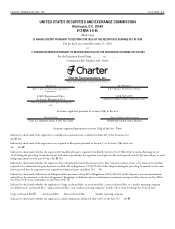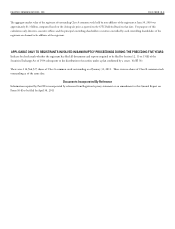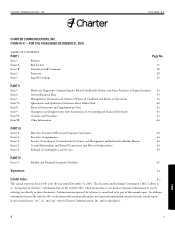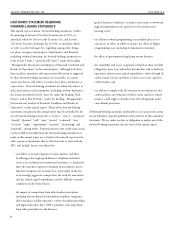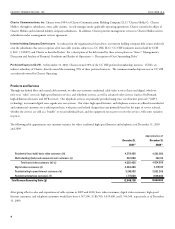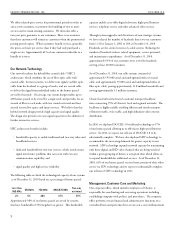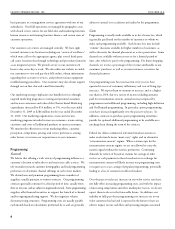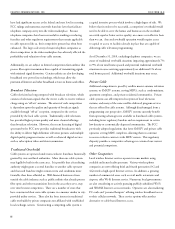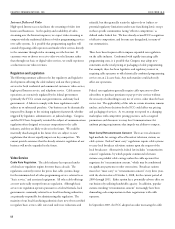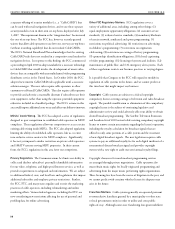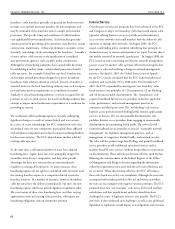Charter 2010 Annual Report Download - page 18
Download and view the complete annual report
Please find page 18 of the 2010 Charter annual report below. You can navigate through the pages in the report by either clicking on the pages listed below, or by using the keyword search tool below to find specific information within the annual report.
We calculate the aging of customer accounts based on the
monthly billing cycle for each account. On that basis,
at December 31, 2010 and 2009, "customers" include
approximately 15,700 and 25,900 persons, respectively, whose
accounts were over 60 days past due in payment, approximately
1,800 and 3,500 persons, respectively, whose accounts were
over 90 days past due in payment, and approximately 1,000 and
2,200 persons, respectively, whose accounts were over 120 days
past due in payment.
“Basic video customers” include all residential customers who
receive video cable services.
Included within "basic video customers" are those in
commercial and multi-dwelling structures, which are calculated
on an equivalent bulk unit (“EBU”) basis. We calculate EBUs
by dividing the bulk price charged to accounts in an area by
the published rate charged to non-bulk residential customers in
that market for the comparable tier of service rather than the
most prevalent price charged. is EBU method of estimating
basic video customers is consistent with the methodology used
in determining costs paid to programmers and is consistent
with the methodology used by other multiple system operators
(“MSOs”). As we increase our published video rates to
residential customers without a corresponding increase in
the prices charged to commercial service or multi-dwelling
customers, our EBU count will decline even if there is no real
loss in commercial service or multi-dwelling customers.
"Digital video customers" include all basic video customers that
have one or more digital set-top boxes or cable cards deployed.
"Residential high-speed Internet customers" represent those
residential customers who subscribe to our high-speed Internet
service.
“Residential telephone customers” represent those residential
customers who subscribe to our telephone service.
"Revenue generating units" represent the sum total of all
basic video, digital video, high-speed Internet and telephone
customers, not counting additional outlets within one
household. For example, a customer who receives two types of
service (such as basic video and digital video) would be treated
a)
b)
c)
d)
e)
f)
g)
as two revenue generating units and, if that customer added
on high-speed Internet service, the customer would be treated
as three revenue generating units. is statistic is computed
in accordance with the guidelines of the National Cable &
Telecommunications Association (“NCTA”).
Video Services
In 2010, residential video services represented approximately 52% of
our total revenues. Our video service offerings include the following:
Basic and Digital Video. All of our video customers receive a
package of basic programming which generally consists of local
broadcast television, local community programming, including
governmental and public access, and limited satellite-delivered
or non-broadcast channels, such as weather, shopping and
religious programming. Our digital video services include a
digital set-top box, an interactive electronic programming guide
with parental controls, an expanded menu of pay-per-view
channels, including OnDemand (available nearly everywhere),
digital quality music channels and the option to also receive
a cable card. In addition to video programming, digital video
service enables customers to receive our advanced video services
such as DVRs and high definition television. Charter also offers
premium sports content over the Internet on charter.net.
Premium Channels. ese channels provide original programming,
commercial-free movies, sports, and other special event
entertainment programming. Although we offer subscriptions
to premium channels on an individual basis, we offer an
increasing number of digital video channel packages and
premium channel packages, and we offer premium channels
combined with our advanced video services. Customers
who purchase premium channels also have access to that
programming OnDemand and increasingly over the Internet.
OnDemand, Subscription OnDemand and Pay-Per-View.
OnDemand service allows customers to select from hundreds of
movies and other programming at any time. ese programming
options may be accessed for a fee or, in some cases, for no
additional charge. In some areas we also offer subscription
OnDemand for a monthly fee or included in a digital tier
premium channel subscription. Pay-per-view channels allow
customers to pay on a per event basis to view a single showing
of a recently released movie, a one-time special sporting event,
•
•
•




